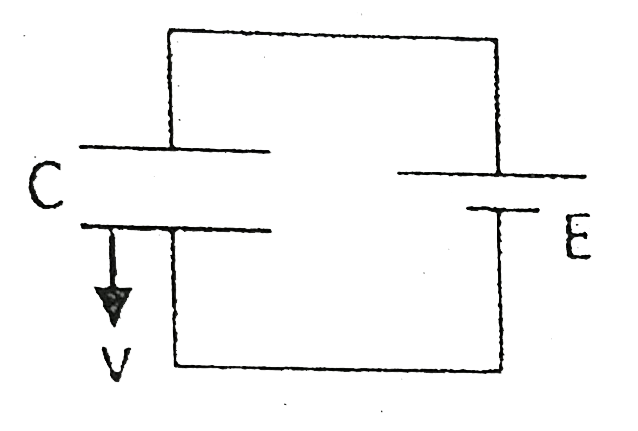A parallel plate capacitor is charged. If the plates are pulled apart
To solve the question regarding the behavior of a charged parallel plate capacitor when its plates are pulled apart, we can follow these steps:
1. Understanding the Capacitor: A parallel plate capacitor consists of two conductive plates separated by a distance, with an insulating material (dielectric) between them. When charged, it stores electrical energy in the electric field created between the plates.
2. Capacitance Formula: The capacitance C of a parallel plate capacitor is given by the formula:
C=ε0Ad
where:
- ε0 is the permittivity of free space,
- A is the area of one of the plates,
- d is the distance between the plates.
3. Effect of Pulling Plates Apart: When the plates are pulled apart, the distance d increases. According to the capacitance formula, if d increases, the capacitance C decreases since capacitance is inversely proportional to the distance between the plates.
4. Charge and Voltage Relationship: The relationship between charge Q, capacitance C, and voltage V is given by:
Q=C⋅V
If the capacitor is disconnected from the battery, the charge Q remains constant because there is no external circuit to allow charge to flow.
5. Analyzing the Situation: Since the charge Q remains constant and the capacitance C decreases (as d increases), we can analyze the effect on voltage V:
V=QC
As C decreases, V must increase to maintain the equality, since Q is constant.
6. Conclusion: Therefore, when the plates of a charged parallel plate capacitor are pulled apart, the capacitance decreases, and the voltage across the plates increases. The charge remains constant throughout this process.
Final Answer:
When a charged parallel plate capacitor has its plates pulled apart, the capacitance decreases, the voltage increases, and the charge remains constant.
---
C=ε0Ad
where:
- ε0 is the permittivity of free space,
- A is the area of one of the plates,
- d is the distance between the plates.
Q=C⋅V
If the capacitor is disconnected from the battery, the charge Q remains constant because there is no external circuit to allow charge to flow.
V=QC
As C decreases, V must increase to maintain the equality, since Q is constant.
When a charged parallel plate capacitor has its plates pulled apart, the capacitance decreases, the voltage increases, and the charge remains constant.
Topper's Solved these Questions
- ELECTROSTATIC POTENTIAL AND CAPACITANCE BOOK - AAKASH INSTITUTE ENGLISHCHAPTER - ELECTROSTATIC POTENTIAL AND CAPACITANCE EXERCISE - ASSIGNMENT (SECTION-A) Objective Type Questions (Only one answer)
53 Videos
- ELECTROSTATIC POTENTIAL AND CAPACITANCE BOOK - AAKASH INSTITUTE ENGLISHCHAPTER - ELECTROSTATIC POTENTIAL AND CAPACITANCE EXERCISE - SECTION-B (OBJECTIVE TYPE QUESTIONS (ONLY ONE ANSWER) )
1 Video
- ELECTROMAGNETIC WAVESBOOK - AAKASH INSTITUTE ENGLISHCHAPTER - ELECTROMAGNETIC WAVESEXERCISE - ASSIGNMENT SECTION - D Assertion-Reason Type Questions
25 Videos
- GRAVITATION BOOK - AAKASH INSTITUTE ENGLISHCHAPTER - GRAVITATION EXERCISE - ASSIGNMENT SECTION - D (ASSERTION-REASON TYPE QUESTIONS)
15 Videos
Similar Questions
A parallel plate capacitor is charged and then isolated. The effect of increasing the plate separation on charge, potential and capacitance respectively are
View SolutionA parallel plate capacitor is connected to a battery. The plates are pulled apart with uniform speed. If x is the separation between the plates, then the rate of change of electrostatic energy of the capacitor is proportional to
View Solution
Knowledge Check
A parallel plate capacitor is charged and then isolated. The effect of increasing the plate separation on charge, potential and capacitance respectively are
Aconstant, decrease, decreaseBincrease, decreases, decreasesCconstant, decreases, increasesDconstant, increases, decreases.
A parallel plate capacitor is charged and then isolated. On increasing the plate separation
View SolutionA parallel plate capacitor is charged from a cell and then isolated from it. The separation between the plates is now increased
View SolutionA parallel plate capacitor is charged from a cell and then isolated from it. The separation between the plates is now increased
View SolutionAn ideal cell is connected across a capacitor as shown in figure. The initial separation between the plates of a parallel plate capacitor is d. The lower plate is pulled down with a uniform velocity v. Neglect the resistance of the cirucit. Then the variation of charge on capacitor with time is given by

View SolutionA parallel plate capacitor is charged and the charging battery is then disconnected. If the plates of the capacitor are moved farther apart by means of insulating handles:
View SolutionA parallel plate capacitor has capacitance of 1.0F. If the plates are 1.0mm apart, what is the area of the plates?
View SolutionA parallel plate capacitor is charged and then the battery is disconnected. When the plates of the capacitor are brought closer, then
View Solution
